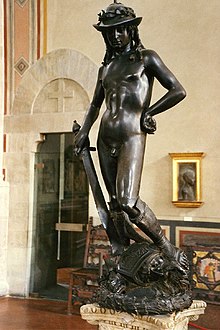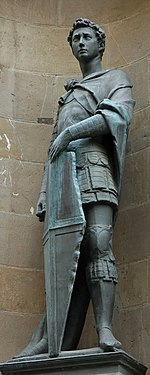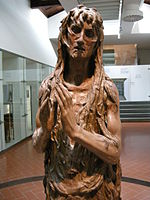Shipping from Europe with tracking number
55mm,golden bronze,Italy
Donato di Niccolò di Betto Bardi (c. 1386 – 13 December 1466), better known as Donatello (English: /ˌdɒnəˈtɛloʊ/[1] Italian: [donaˈtɛllo]), was an Italian sculptor of the Renaissance. Born in Florence, he studied classical sculpture and used this to develop a complete Renaissance style in sculpture, whose periods in Rome, Padua and Siena introduced to other parts of Italy a long and productive career. He worked with stone, bronze, wood, clay, stucco and wax, and had several assistants, with four perhaps being a typical number. Though his best-known works were mostly statues in the round, he developed a new, very shallow, type of bas-relief for small works, and a good deal of his output was larger architectural reliefs.
In Florence, Donatello assisted Lorenzo Ghiberti with the statues of prophets for the north door of the Baptistery of Florence Cathedral, for which he received payment in November 1406 and early 1408. In 1409–1411 he executed the colossal seated figure of Saint John the Evangelist, which until 1588 occupied a niche of the old cathedral façade, and is now placed in the Museo dell'Opera del Duomo. This work marks a decisive step forward from late Gothic Mannerism in the search for naturalism and the rendering of human feelings.[4] The face, the shoulders and the bust are still idealized, while the hands and the fold of cloth over the legs are more realistic.
In 1411–1413, Donatello worked on a statue of St. Mark for the guild church of Orsanmichele. In 1417 he completed the Saint George for the Confraternity of the Cuirass-makers. The elegant St. George and the Dragon relief on the statue's base, executed in schiacciato (a very low bas-relief) is one of the first examples of central-point perspective in sculpture. From 1423 is the Saint Louis of Toulouse for the Orsanmichele, now in the Museum of the Basilica di Santa Croce. Donatello had also sculpted the classical frame for this work, which remains, while the statue was moved in 1460 and replaced by the Incredulity of Saint Thomas by Verrocchio.
Between 1415 and 1426, Donatello created five statues for the campanile of Santa Maria del Fiore in Florence, also known as the Duomo. These works are the Beardless Prophet; Bearded Prophet (both from 1415); the Sacrifice of Isaac (1421); Habbakuk (1423–25); and Jeremiah (1423–26); which follow the classical models for orators and are characterized by strong portrait details. From the late teens is the Pazzi Madonna relief in Berlin. In 1425, he executed the notable Crucifix for Santa Croce; this work portrays Christ in a moment of the agony, eyes and mouth partially opened, the body contracted in an ungraceful posture.
From 1425 to 1427, Donatello collaborated with Michelozzo on the funerary monument of the Antipope John XXIII for the Battistero in Florence. Donatello made the recumbent bronze figure of the deceased, under a shell. In 1427, he completed in Pisa a marble relief for the funerary monument of Cardinal Rainaldo Brancacci at the church of Sant'Angelo a Nilo in Naples. In the same period, he executed the relief of the Feast of Herod and the statues of Faith and Hope for the Baptistery of San Giovanni in Siena. The relief is mostly in stiacciato, with the foreground figures are done in bas-relief.
Major commissions in Florence[edit]
The dating of the statue[clarification needed] is not settled, though recent scholarship has indicated it was made around 1460. It is certain that Cosimo de' Medici, the foremost art patron of his era, commissioned from Donatello the bronze David (now in the Bargello) for the court of his Palazzo Medici. This is now Donatello's most famous work, and the first known free-standing nude statue produced since antiquity. Conceived fully in the round, independent of any architectural surroundings, and largely representing an allegory of the civic virtues triumphing over brutality and irrationality, it is arguably the first major work of Renaissance sculpture. Also from this period is the disquietingly small Love-Atys, housed in the Bargello.
Some have perceived the David as having homo-erotic qualities, and have argued that this reflected the artist's own orientation.[5] The historian Paul Strathern makes the claim that Donatello made no secret of his homosexuality, and that his behaviour was tolerated by his friends.[6] The main evidence comes from anecdotes by Angelo Poliziano in his "Detti piacevoli", where he writes about Donatello surrounding himself with "handsome assistants" and chasing in search of one that had fled his workshop.[7] This may not be surprising in the context of attitudes prevailing in the 15th- and 16th-century Florentine republic. However, little detail is known with certainty about his private life, and no mention of his sexuality has been found in the Florentine archives (in terms of denunciations)[8] albeit which during this period are incomplete.[9]
When Cosimo was exiled from Florence, Donatello went to Rome, remaining until 1433. The two works that testify to his presence in this city, the Tomb of Giovanni Crivelli at Santa Maria in Aracoeli, and the Ciborium at St. Peter's Basilica, bear a strong stamp of classical influence.
Donatello's return to Florence almost coincided with Cosimo's. In May 1434, he signed a contract for the marble pulpit on the facade of Prato cathedral, the last project executed in collaboration with Michelozzo. This work, a passionate, pagan, rhythmically conceived bacchanalian dance of half-nude putti, was the forerunner of the great Cantoria, or singing tribune, at the Duomo in Florence on which Donatello worked intermittently from 1433 to 1440 and was inspired by ancient sarcophagi and Byzantine ivory chests. In 1435, he executed the Annunciation for the Cavalcanti altar in Santa Croce, inspired by 14th-century iconography, and in 1437–1443, he worked in the Old Sacristy of the San Lorenzo in Florence, on two doors and lunettes portraying saints, as well as eight stucco tondoes. From 1438 is the wooden statue of St. John the Baptist for Santa Maria Gloriosa dei Frari in Venice. Around 1440, he executed a bust of a Young Man with a Cameo now in the Bargello, the first example of a lay bust portrait since the classical era.
In Padua[edit]
In 1443, Donatello was called to Padua by the heirs of the famous condottiero Erasmo da Narni (better known as the Gattamelata, or "Honey-Cat"), who had died that year. Completed in 1450 and placed in the square facing the Basilica of St. Anthony, his Equestrian Monument of Gattamelata was the first example of such a monument since ancient times. (Other equestrian statues, from the 14th century, had not been executed in bronze and had been placed over tombs rather than erected independently, in a public place.) This work became the prototype for other equestrian monuments executed in Italy and Europe in the following centuries.
For the Basilica of St. Anthony, Donatello created, most famously, the bronze Crucifix of 1444–47 and additional statues for the choir, including a Madonna with Child and six saints, constituting a Holy Conversation, which is no longer visible since the renovation by Camillo Boito in 1895. The Madonna with Child portrays the Child being displayed to the faithful, on a throne flanked by two sphinxes, allegorical figures of knowledge. On the throne's back is a relief of Adam and Eve. During this period—1446–50—Donatello also executed four extremely important reliefs with scenes from the life of St. Anthony for the high altar.
Main works[edit]
- St. Mark (1411–13), Orsanmichele, Florence
- St. George Tabernacle (c. 1415–17) – Museo Nazionale del Bargello, Florence
- Prophet Habakkuk (1423–25) – Museo dell'Opera del Duomo, Florence
- The Feast of Herod (c. 1425) – Baptismal font, Baptistry of San Giovanni, Siena
- David (c. 1425–30) – Museo Nazionale del Bargello, Florence
- Madonna of the Clouds (c. 1425–35) marble relief, Museum of Fine Arts, Boston
- Equestrian Monument of Gattamelata (1445–50) – Piazza del Santo, Padua
- Magdalene Penitent (c. 1455) – Museo dell'Opera del Duomo, Florence
- Judith and Holofernes (1455–1460) – Palazzo Vecchio, Florence
- Virgin and Child with Four Angels or Chellini Madonna (1456), Victoria and Albert Museum





